Key takeaways:
- Data interpretation requires understanding context and recognizing potential biases that influenced outcomes.
- Effective visualization and collaboration can transform complex data into clear, actionable insights.
- Overcoming challenges in data interpretation often involves breaking down datasets, iterative analysis, and embracing storytelling techniques.
- Flexibility, skepticism, and adaptability are crucial for uncovering deeper insights and ensuring accurate interpretations.
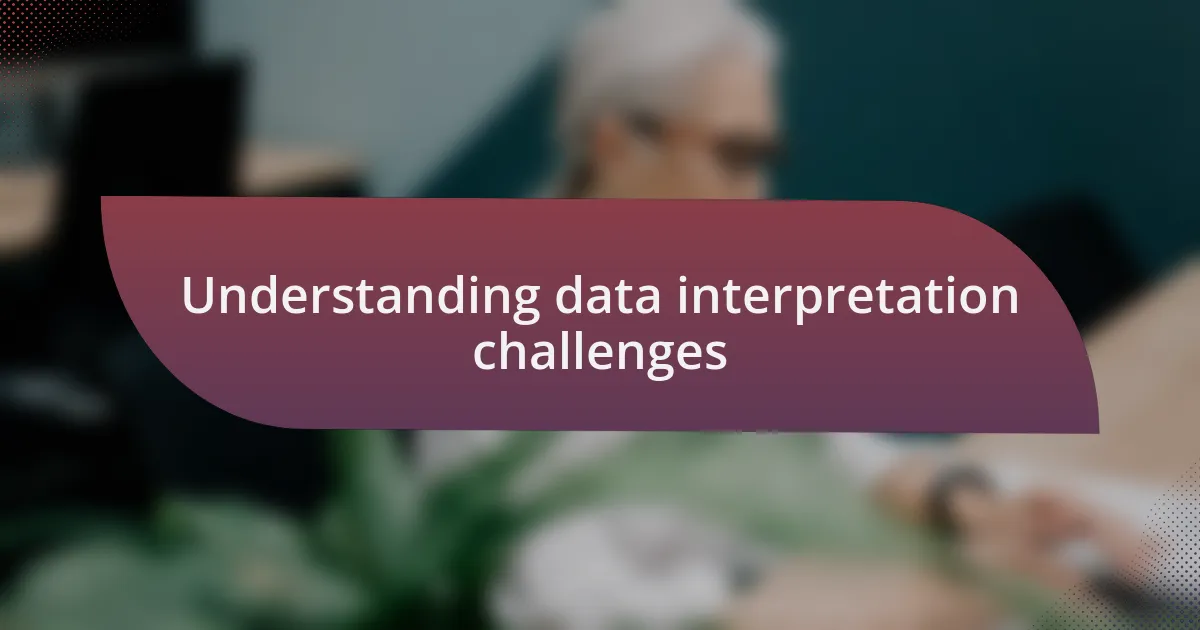
Understanding data interpretation challenges
Data interpretation challenges can often feel like navigating a maze without a map. I remember a time when I was analyzing survey results and found that the raw numbers didn’t tell the whole story. Was it the methodology that skewed the data, or were there external factors influencing the responses? This instance brought to light the importance of understanding context and the potential biases that can influence perceptions.
Every dataset has its quirks and nuances that can lead to misinterpretation. I once misread a correlation as causation in a project, only to later realize the critical error that could have resulted in misguided policy recommendations. It’s those moments that remind us how essential it is to dig deeper, to ask the right questions, and to constantly evaluate our assumptions.
I often reflect on the emotional weight that comes with interpreting data. The stakes are frequently high; decisions based on flawed interpretations can impact lives and policies profoundly. This urgency drives me to stay vigilant, ensuring that I consider every angle before arriving at conclusions. Have you ever felt the weight of making a decision based on data? It’s a potent reminder of the responsibility that comes with our analysis.
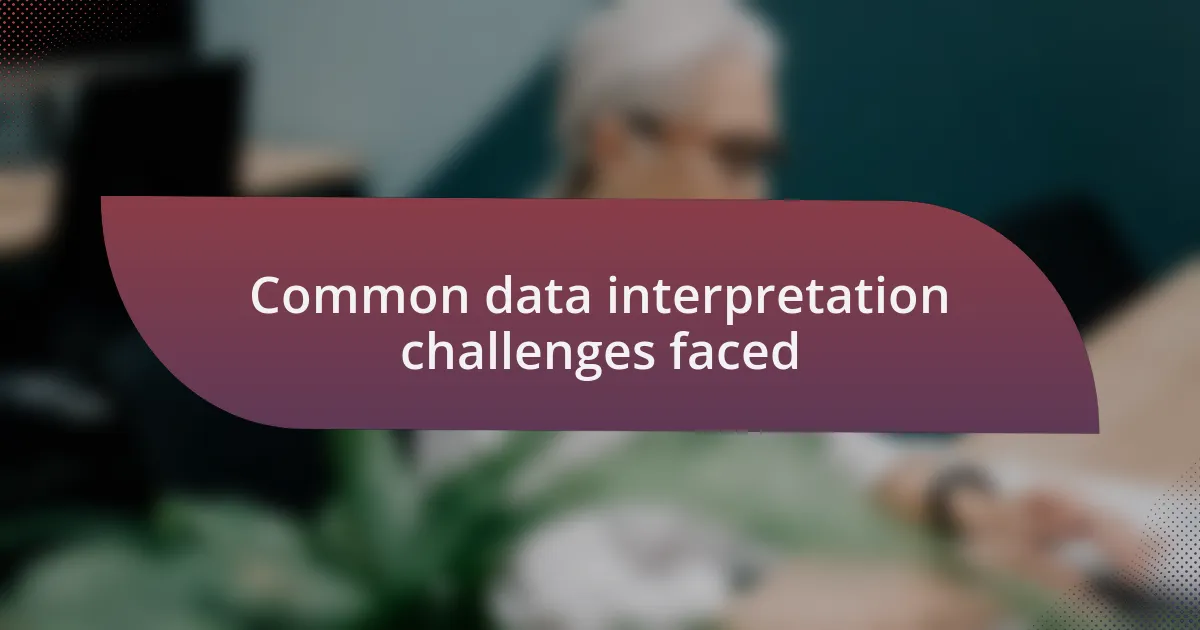
Common data interpretation challenges faced
When it comes to data interpretation, one major challenge I’ve encountered is dealing with incomplete datasets. I remember analyzing economic indicators for policy recommendations and realizing some critical data points were missing. Have you ever faced a similar situation where you felt like you were trying to complete a puzzle without all the pieces? It’s frustrating, but it pushes you to think creatively about how to fill in the gaps while being mindful of how those omissions might skew your conclusions.
Another challenge I’ve regularly faced is the difficulty of visualizing data effectively. Once, I created a graph to illustrate trends in public health data, but the way I presented it ended up confusing my audience instead of clarifying the findings. Reading the room and adjusting my visuals is crucial. Have you noticed how the wrong chart can obscure the data’s message? It’s a reminder that clear communication is just as important as accurate analysis.
Lastly, I often grapple with the challenge of competing narratives that emerge from the same data. During a project focused on demographic shifts, I found myself torn between two interpretations that painted vastly different pictures. It made me question: how do I navigate conflicting narratives to find the truth? This calls for a delicate balance of critical thinking and empathy, as the impact of our interpretations can ripple out into real-world implications for communities and policymakers alike.
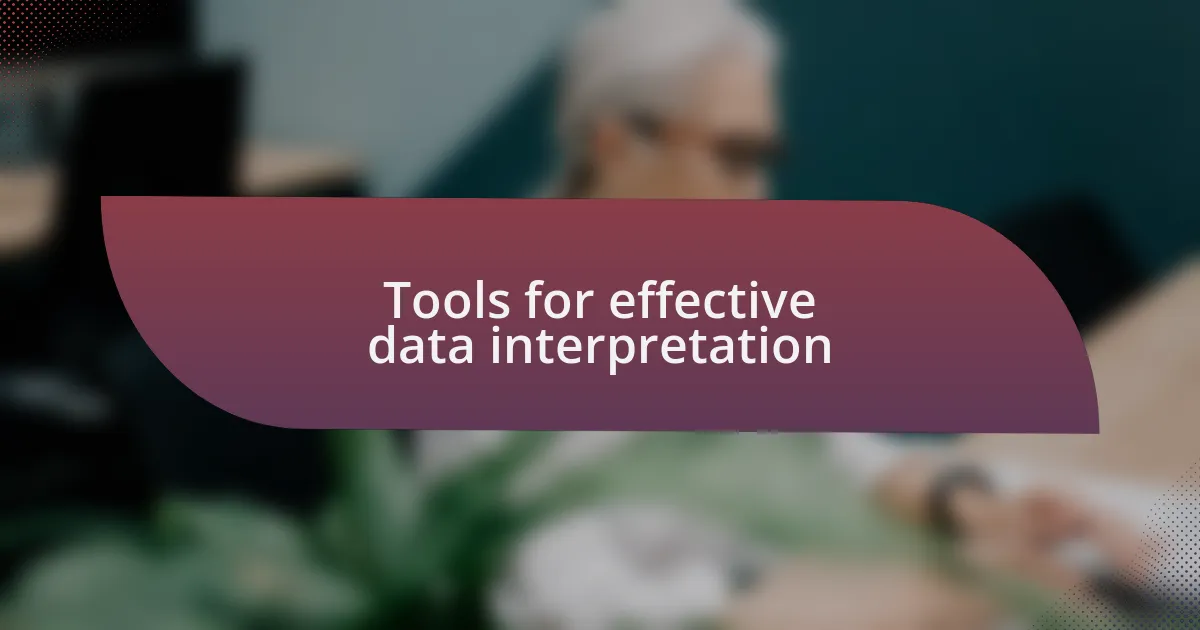
Tools for effective data interpretation
When it comes to tools for effective data interpretation, one of my go-to resources is data visualization software. I remember a specific instance when I used Tableau to dissect complex policy data, and the visual impact was immediate. Have you ever seen how a well-constructed dashboard can transform a sea of numbers into an intuitive narrative? It was a game-changer for helping stakeholders grasp insights quickly and effectively.
Another tool that has served me well is statistical analysis software like R or Python’s libraries. I once faced a daunting dataset with numerous variables, and applying regression analysis allowed me to uncover relationships that weren’t immediately obvious. This experience made me appreciate how these tools can empower us to extract meaningful conclusions from seemingly chaotic data. Isn’t it fascinating how a few lines of code can unlock such depth?
Moreover, engaging with peers to gain different perspectives on data interpretation has been invaluable. I recall a brainstorming session where a colleague offered an entirely new angle on a dataset I thought I understood well. This collaborative approach can often illuminate aspects of the data that I might overlook. Have you experienced how a shared conversation can reveal insights that one might miss in isolation? It’s a reminder that sometimes the best tool for interpretation is simply the exchange of ideas with others.
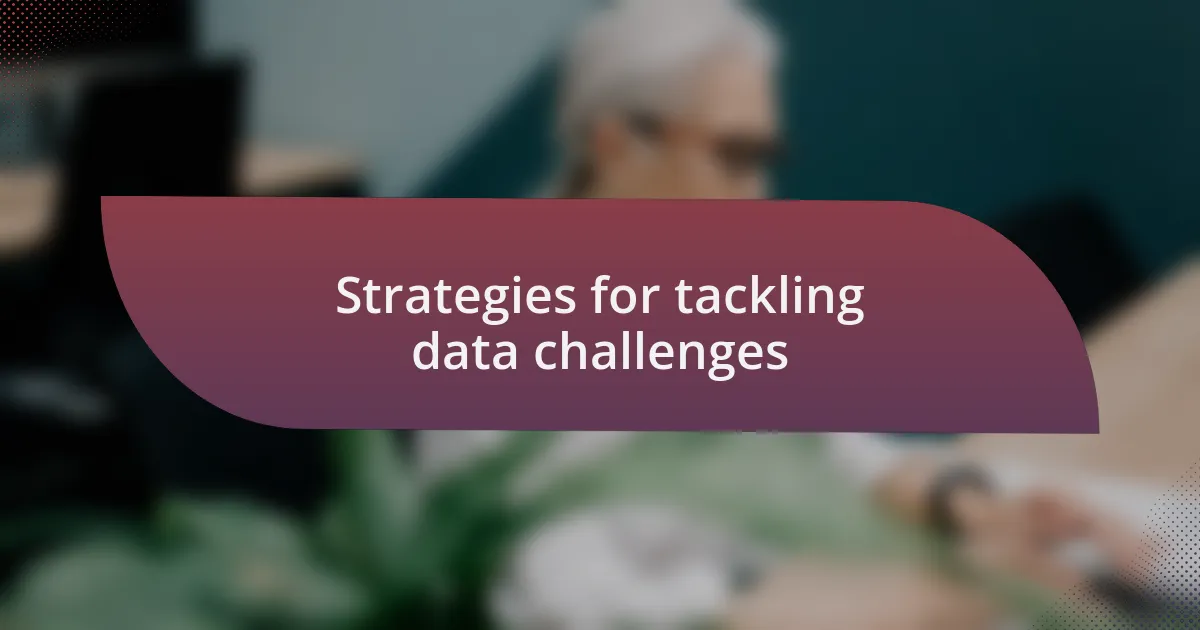
Strategies for tackling data challenges
A strategy I often rely on is breaking down large datasets into smaller, more manageable parts. During one particular project, I tackled a massive survey dataset by categorizing responses based on demographics; this allowed me to focus on specific segments and derive targeted insights. Have you ever noticed how simplifying complexity can lead to clarity? It’s as if the fog lifts, revealing actionable information that was previously obscured.
Additionally, I advocate for iterative analysis—constantly revisiting and refining my findings. I recall working on a report where initial conclusions seemed solid, but after a few rounds of revisiting the data, I stumbled upon inconsistencies that drastically altered my perspective. Isn’t it interesting how a fresh look can sometimes reveal truths we initially missed? Embracing this cyclical process of evaluation has proven to be instrumental in my work.
Finally, leveraging storytelling techniques to frame data is a tactic that has helped me resonate with a broader audience. I vividly remember crafting a presentation where I wove data points into a narrative about community impact, turning statistics into relatable stories. Have you ever tried transforming numbers into a tale that speaks to your audience’s emotions? This approach not only humanizes the data but also bridges the gap between analytical insights and real-world relevance.
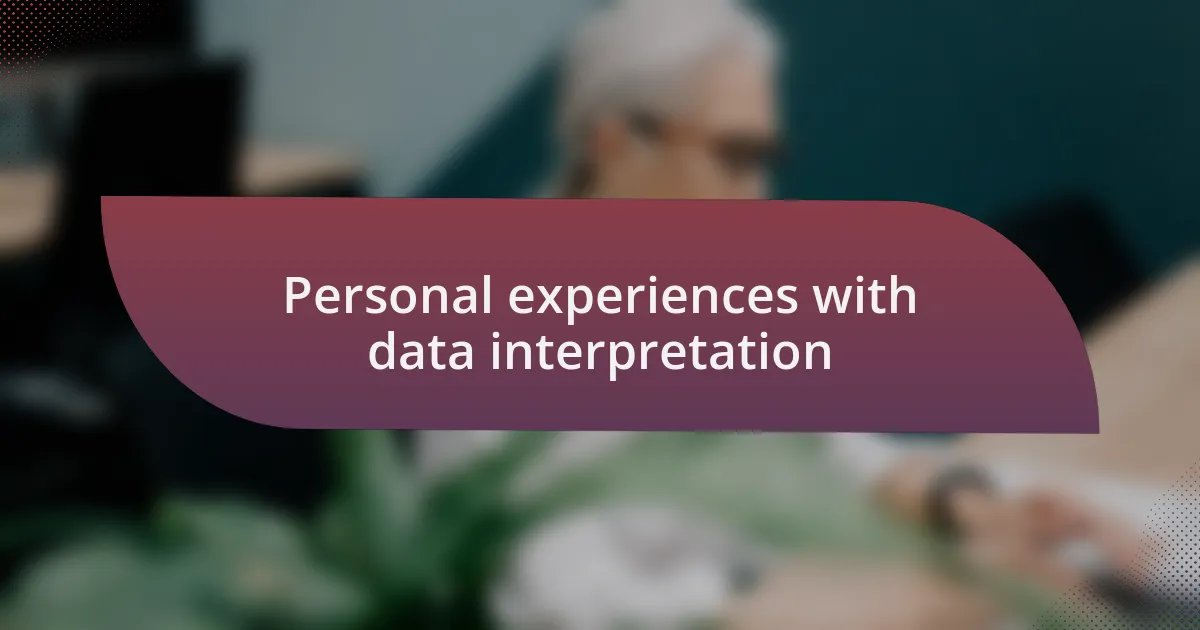
Personal experiences with data interpretation
While working on an evaluation of a local health initiative, I encountered a dataset that seemed to tell a conflicting story. At first, the numbers indicated a decrease in health issues, but anecdotal evidence from community members painted a different picture. I felt a mix of frustration and determination—how could the data and lived experiences be so at odds? This drove me to conduct follow-up interviews that ultimately provided context and revealed underlying factors influencing the numbers. It taught me that data is just one piece of a larger puzzle.
In another project focused on education policy, I consistently faced challenges interpreting student performance metrics across varying demographics. I remember feeling lost as I navigated through the statistics, trying to find patterns. Then I decided to visualize the data with graphs, and suddenly, the trends began to emerge. Have you ever experienced that moment of clarity when a visual representation makes the information leap off the page? It felt empowering, transforming the raw data into actionable insights that could drive meaningful discussions.
One particularly memorable instance involved analyzing electoral data during a campaign. I recalled sitting in a quiet café, poring over the figures, and realizing that certain demographics were significantly underrepresented in the raw counts. I felt a sense of responsibility wash over me, as if I needed to give these voices a platform. This realization spurred me to pivot my analysis and advocate for outreach strategies, reminding me that data interpretation is not just about numbers, but about the stories those numbers tell us.
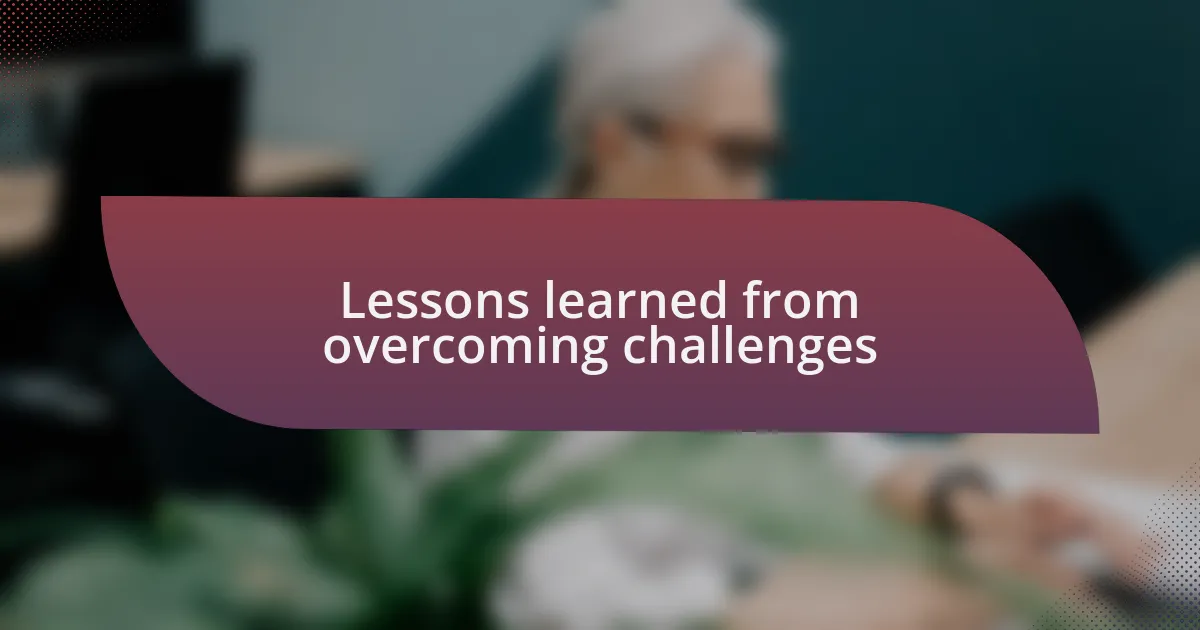
Lessons learned from overcoming challenges
Overcoming data interpretation challenges has instilled in me a deep appreciation for context. I remember when I misinterpreted a set of financial data, thinking it indicated declining resource allocations for community programs. After discussing my findings with colleagues, their perspectives helped me understand the external factors influencing the budget. This experience taught me that collaboration is vital; sometimes, a fresh set of eyes can illuminate aspects of data that may initially seem obscured.
One lesson that stands out is the importance of adaptability. I once spent hours scrutinizing poll data, convinced that the trends were static. However, when I shifted my approach to analyze the data over time, I noticed fluctuations that offered invaluable insights into voter behavior. Have you ever had to pivot your strategy and found nuggets of wisdom hidden in the chaos? This reinforced the belief that flexibility in our data interpretation approach can often lead to breakthrough moments.
Additionally, I learned that skepticism can be a powerful tool. I recall a project where the data showed a high approval rating for a policy, but my intuition urged me to dig deeper. By questioning the source and methodology, I uncovered biases that skewed the results. This experience solidified my understanding that being critical of the data is essential in ensuring that our conclusions reflect reality rather than assumptions. Trusting my instincts and validating information can lead to more robust interpretations.